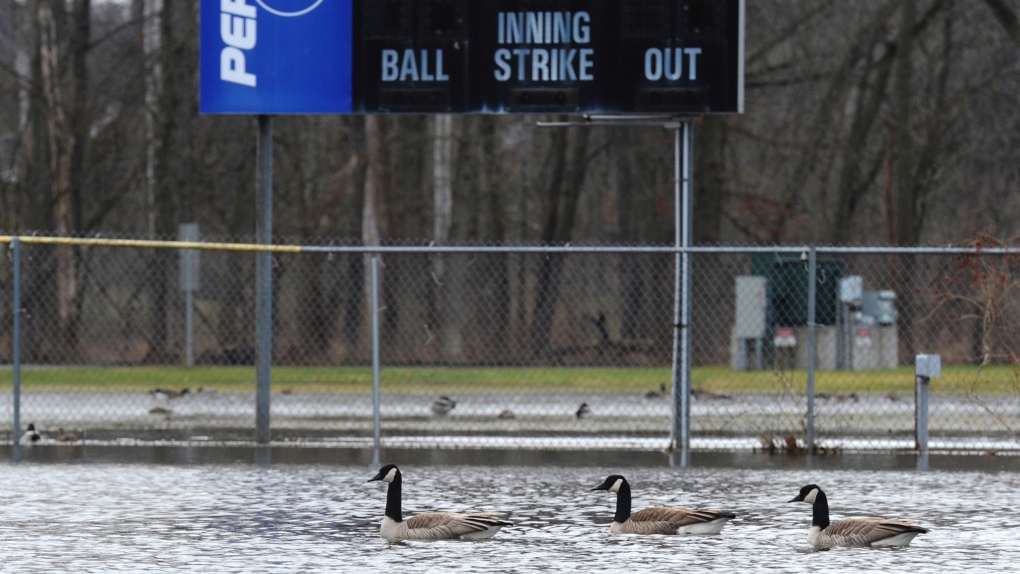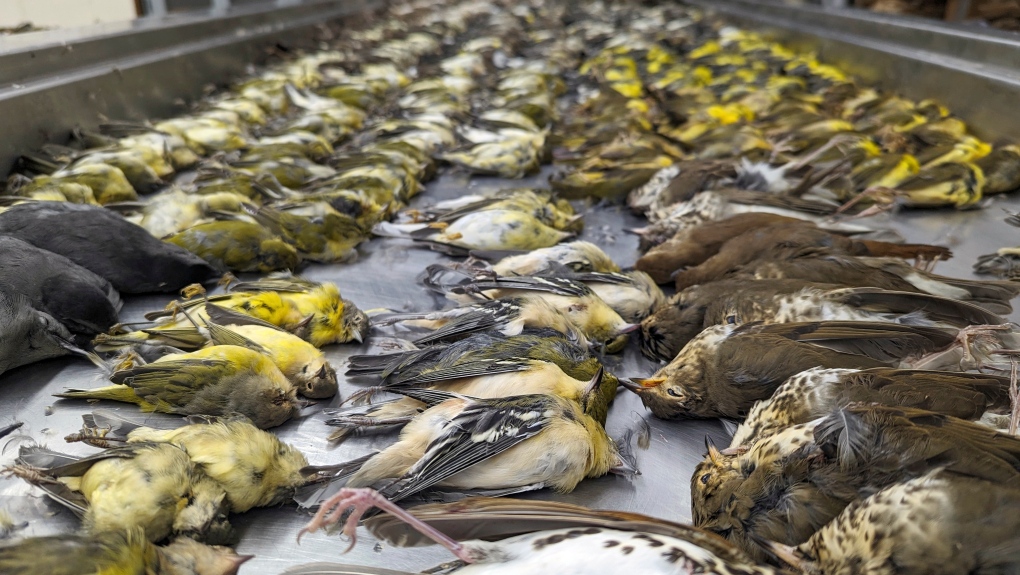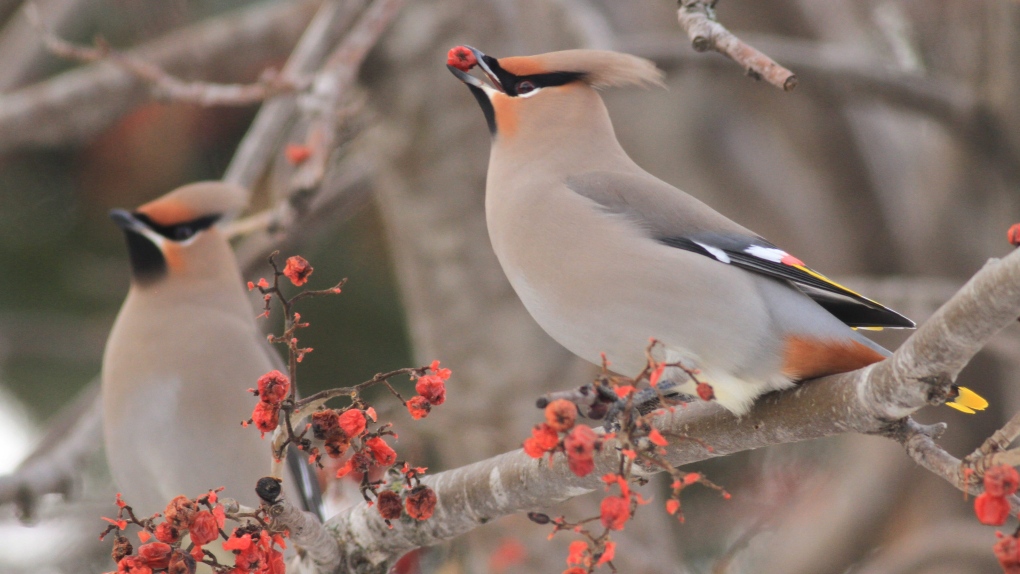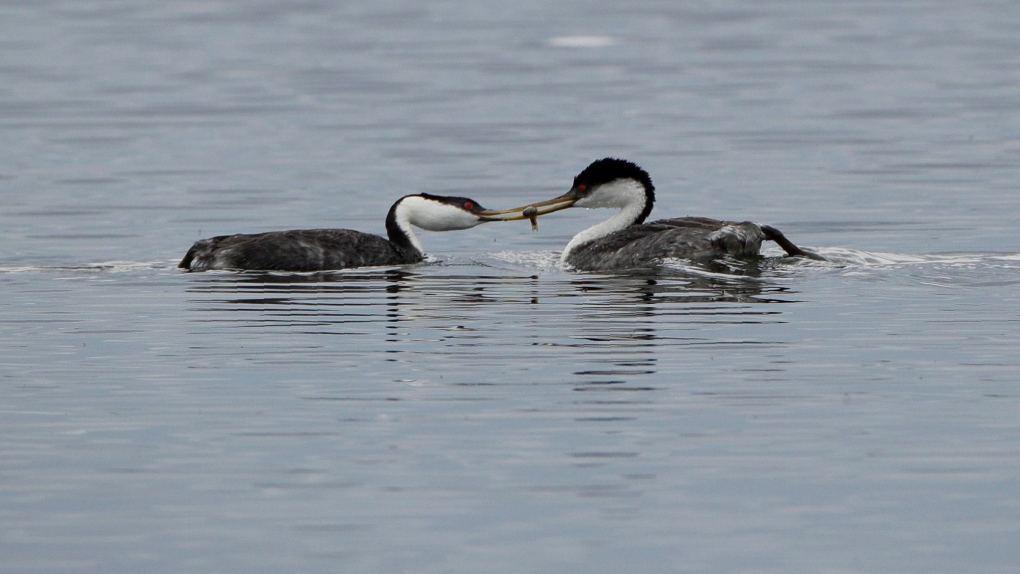'We're losing billions of birds': Backyard risks to Alberta's birds and how you can mitigate them
 Snow geese, with their reputation for being one of the noisiest waterfowl, are seen during their migratory movements at the Reservoir Beaudet in Quebec on Nov. 1, 2023. Millions of the birds will migrate through Alberta each fall. (Bernard Brault)
Snow geese, with their reputation for being one of the noisiest waterfowl, are seen during their migratory movements at the Reservoir Beaudet in Quebec on Nov. 1, 2023. Millions of the birds will migrate through Alberta each fall. (Bernard Brault)
Fall is a busy time for birds in the capital region, with hundreds of species coming or going from the Edmonton area.
As birdwatchers say goodbye to the iconic Canada goose and noisy high-flying flocks of tens-of-thousands of sandhill cranes, they may start catching glimpses of juncos, pine grosbeaks, and bohemian waxwings as they arrive in Edmonton to hunker down for the winter.
Those looking for bigger birds will soon be able to find bald eagles galore at Hastings Lake, southeast of Sherwood Park, where they'll hunt waterfowl until the water freezes over.
Global Bird Rescue, estimates four billion birds will navigate man-made environments as they travel south from North America during fall migration.
Kim Blomme, director of research and policy at animal rescue organization WildNorth, said it can be a vulnerable time – especially for those spring chicks undertaking their first trips as juvenile birds.
Many won't survive due to predation, inexperience or bad weather. Tens-of-millions of others will die preventable deaths, often in our own backyards.
"Window strikes and cat catches – those really are the two major impacts on birds, and we're losing billions of birds because of those two things," Blomme said.
 Canada geese cruise past a scoreboard on a flooded portion of a former baseball diamond in Michigan on Jan. 31, 2024. Flocks will leave Alberta in the fall in favour of open water and food in the U.S., southern Canada or as far as northeastern Mexico. (Don Campbell)
Canada geese cruise past a scoreboard on a flooded portion of a former baseball diamond in Michigan on Jan. 31, 2024. Flocks will leave Alberta in the fall in favour of open water and food in the U.S., southern Canada or as far as northeastern Mexico. (Don Campbell)
Preventable deaths
Window strikes are a leading cause of death for birds year-round, with migrating birds at greater risk.
While there are steps cities, like Edmonton, can take, Blomme said preventing those deaths is a shared responsibility.
"Many of the strikes are happening just in homes," Blomme said. "It isn't necessarily our big buildings."
What looks like a door or window to us, looks to a bird like a clear flight path into a building or toward the landscape or sky reflected in the glass.
Humans aren't always great at distinguishing glass from the great outdoors. However, where our occasional run-ins can be funny, they're no laughing matter for birds.
"(We see) a lot of traumatic brain injury," Blomme said. "Some of the owls, because their eyes are facing forward, will see eye damage … We also see collarbone and coracoid fractures."
Most birds will be killed in the crash, with Environment Canada estimating up to 42 million birds die each year in window strikes.
 This photo provided by the Chicago Field Museum shows the bodies of migrating birds on Oct. 5, 2023, at the Chicago Field Museum in Chicago. The birds were killed when they flew into the windows of the McCormick Place Lakeside Center, a Chicago exhibition hall, the night of Oct. 4-5. (Daryl Coldren/Chicago Field Museum)The ones that survive, Blomme said, often die later as a result of those injuries.
This photo provided by the Chicago Field Museum shows the bodies of migrating birds on Oct. 5, 2023, at the Chicago Field Museum in Chicago. The birds were killed when they flew into the windows of the McCormick Place Lakeside Center, a Chicago exhibition hall, the night of Oct. 4-5. (Daryl Coldren/Chicago Field Museum)The ones that survive, Blomme said, often die later as a result of those injuries.
Light pollution can worsen the problem during migration periods, as some species of bird fly at night, said Meghan Jacklin, conservation team lead with conservation association Edmonton Area Land Trust (EALT).
"They can be drawn towards light from windows and then strike the windows at night," Jacklin said. "Other birds that are higher up can also be disoriented by the light from below."
Jacklin and Blomme both said cat catches are the next biggest threat to bird populations, and it's estimated that between 100 and 350 million wild birds are caught and killed each year across Canada.
Smaller birds like warblers, finches and sparrows are in greater danger, Jacklin said, adding some of those species are already at risk in our province.
"Many of our small songbirds, especially during parts of their migration, they will move along the ground, they'll stop and forage. They need to eat on the way, and then they're vulnerable to pets predating them during that time," Jacklin said.
How to help
Most cat kills are made by feral or rural felines, but Jacklin and Blomme said people can help keep urban birds safe by limiting unsupervised outdoor time for pets.
"We really, really encourage people to use catios for their cats," Blomme said. "Or train their cats on an outdoor harness and leash and be out there supervising the cat.
"They really don't need to be roaming freely to have enrichment. We can provide the enrichment they need by playing with them more inside the house."
"I've heard fantastic things about catios," Jacklin said. "They really do a great job of protecting the cat from danger to itself, as well as protecting migratory birds from the cat."
 A yellow-rumper warbler can be seen New Mexico 2010. Small songbirds, like warblers, at are greater risk of being killed by outdoor cats - a cause of death estimated to kill up to 350 million birds each year in Canada. (Dean Hanson)Blomme said it's very easy to prevent bird strikes at home using properly spaced decals, tape or paint to mark the glass.
A yellow-rumper warbler can be seen New Mexico 2010. Small songbirds, like warblers, at are greater risk of being killed by outdoor cats - a cause of death estimated to kill up to 350 million birds each year in Canada. (Dean Hanson)Blomme said it's very easy to prevent bird strikes at home using properly spaced decals, tape or paint to mark the glass.
"The most effective way is actually a series of dots that you can kind of paint on the window with chalk paint," she said. "You don't have to expend a ton of money."
"Some people don't like to look at that," she added. "But you actually get used to it pretty quickly."
Drawing the blinds at night can help cut down on light pollution and night window strikes during migration periods in the spring and fall, Jacklin said.
In the winter, Blomme said bohemian waxwings can be at a greater risk of window strikes thanks to a diet of fermented fruit from mountain ash trees.
"One lady called, she had 14 birds hit her window," she added. "They kind of get a little bit disoriented from meeting the overripe berries,.
"And then they're flock birds too, so they follow each other."
 Bohemian waxwings feed on mountain ash berries Alaska in 2015. The birds start arriving in Edmonton in September, and they will spend the winter eating frozen fruit - including fermented berries on mountain ash trees, which can make them more suspectable to window strikes. (Dan Joling)If you find an injured bird in your yard, you can help by getting it into a ventilated box – large enough for the bird to stand up in – and bringing it to WildNorth.
Bohemian waxwings feed on mountain ash berries Alaska in 2015. The birds start arriving in Edmonton in September, and they will spend the winter eating frozen fruit - including fermented berries on mountain ash trees, which can make them more suspectable to window strikes. (Dan Joling)If you find an injured bird in your yard, you can help by getting it into a ventilated box – large enough for the bird to stand up in – and bringing it to WildNorth.
Blomme said you can use a tea towel to toss over the bird to pick it up, and she recommends wearing gloves, as even smaller birds can have talons that pack a punch.
"Gently collect them up, put them in the box, take the towel off, and then bring them in to us," she said.
"If we can get them off the ground away from cats, away from dogs, and then get them in care and support them … there's a certain percentage of those that we can pull through."
Enjoy from a distance
Jacklin said there are more than 50 at-risk species of bird – including western grebes and purple martins – moving through the region during fall.
Other birds, like black capped chickadees and hairy and downy woodpeckers, spend all year in our city.
She said anyone wanting to enjoy their company are most likely to find flocks stopping in areas with water and lots of vegetation.
"My favorite park within the city limits is any part of the White Mud ravine," she added. "River Valley trails, and really any city park that has small water bodies or wetlands."
Outside of the city, she recommends Lois Hole Provincial Park, Elk Island National Park or one of the EALT's 22 local conserved lands (most of which are open to the public).
 A male western grebe, right, shares a fish with his mate as they float on a wetland in North Dakota on Saturday, June 22, 2019. Western grebes have bee a species at risk in Alberta since 2015, due to nest disturbances and other disturbances like oil spills in wintering areas. (Charlie Riedel)Jacklin said it's always best to keep your distance, especially during migration.
A male western grebe, right, shares a fish with his mate as they float on a wetland in North Dakota on Saturday, June 22, 2019. Western grebes have bee a species at risk in Alberta since 2015, due to nest disturbances and other disturbances like oil spills in wintering areas. (Charlie Riedel)Jacklin said it's always best to keep your distance, especially during migration.
"Make sure that (you're) not approaching them and forcing them to to fly away; that drains their energy," she said. "Use binoculars and cameras and just watch them and enjoy their presence."
Wild birds don't need us to feed them, Blomme said, but if you enjoy seeing them in your backyard, there are ways to mitigate some of the risk bird feeders can introduce.
"It's easier for them to come to a feeder, but it also sometimes targets them," she said, adding clever cats will return to feeders and nesting boxes to hunt.
"There's always those unintended consequences."
Nature Canada recommends placing feeders at least 10 metres away from the house near protective cover. They should be cleaned regularly, filled with high-quality food and visitors should be monitored for signs of illness.
More ways to make your home and yard more friendly to local birds can be found on the Cornell Lab website.
People can also get more involved by joining the Edmonton Nature Club, which holds annual bird counts to gather data for Birds Canada and the National Audubon Society. The next count is on Dec. 15.
A 2019 study by Cornell University researchers found the bird population in Canada and the U.S. had dropped by almost three billion since 1970.
CTVNews.ca Top Stories

5 rescued after avalanche triggered north of Whistler, B.C. RCMP say
Emergency crews and heli-skiing staff helped rescue five people who were caught up in a backcountry avalanche north of Whistler, B.C., on Monday morning.
Quebec fugitive killed in Mexican resort town, RCMP say
RCMP are confirming that a fugitive, Mathieu Belanger, wanted by Quebec provincial police has died in Mexico, in what local media are calling a murder.
Bill Clinton hospitalized with a fever but in good spirits, spokesperson says
Former President Bill Clinton was admitted Monday to Georgetown University Medical Center in Washington after developing a fever.
Trump again calls to buy Greenland after eyeing Canada and the Panama Canal
First it was Canada, then the Panama Canal. Now, Donald Trump again wants Greenland. The president-elect is renewing unsuccessful calls he made during his first term for the U.S. to buy Greenland from Denmark, adding to the list of allied countries with which he's picking fights even before taking office.
UN investigative team says Syria's new authorities 'very receptive' to probe of Assad war crimes
The U.N. organization assisting in investigating the most serious crimes in Syria said Monday the country’s new authorities were “very receptive” to its request for cooperation during a just-concluded visit to Damascus, and it is preparing to deploy.
Pioneering Métis human rights advocate Muriel Stanley Venne dies at 87
Muriel Stanley Venne, a trail-blazing Métis woman known for her Indigenous rights advocacy, has died at 87.
King Charles ends royal warrants for Ben & Jerry's owner Unilever and Cadbury chocolatiers
King Charles III has ended royal warrants for Cadbury and Unilever, which owns brands including Marmite and Ben & Jerry’s, in a blow to the household names.
Man faces murder charges in death of woman who was lit on fire in New York City subway
A man is facing murder charges in New York City for allegedly setting a woman on fire inside a subway train and then watching her die after she was engulfed in flames, police said Monday.
Canada regulator sues Rogers for alleged misleading claims about data offering
Canada's antitrust regulator said on Monday it was suing Rogers Communications Inc, for allegedly misleading consumers about offering unlimited data under some phone plans.
































